Unorthodox Istanbul – Via Egnatia Style
This is my first post of many from the recently completed Adventures Abroad Via Egnatia tour led by our good friend Victor Romagnoli. This was a unique tour designed by yours truly and Victor on Malta just after travel resumed post Covid. I described my expectations for this tour in this post and I can say without question that it exceeded them in every way. The name for the tour was Victor’s idea. We would retrace the steps of an ancient Roman road that connected Constantinople to the Adriatic coast and allowed for rapid transport between the eastern and western capitals of the empire. The tour was also meant to include a number of natural history sites such as the Evros Delta and Mount Olympus, alternating with visits to places associated with Alexander the Great and St. Paul among others. The starting place for the tour was Istanbul, but rather than turning south and crossing into Asia as Alison and I had done three times before, we would pass through European Turkey on the way to Greece. For the Istanbul itinerary we wanted something other than the standard Sultanhamet tour of Hagia Sophia, the Blue Mosque and Topkapi. As important as those sites are, Alison and I had seen them only recently for the second or third time and wanted to see more of this ancient city. Our first stop on this unorthodox Istanbul tour will be at the Golden Gate of the Walls of Constantinople.
We had been in Istanbul for a few days before the tour was to start and taken in a number of sites new to us such as the excellent Museum of Islamic Technology and revisited some old favourites like the newly restored Basilica Cistern. As well, in springtime Gulhane Park is a site to behold with tulips, native to Turkey, everywhere.
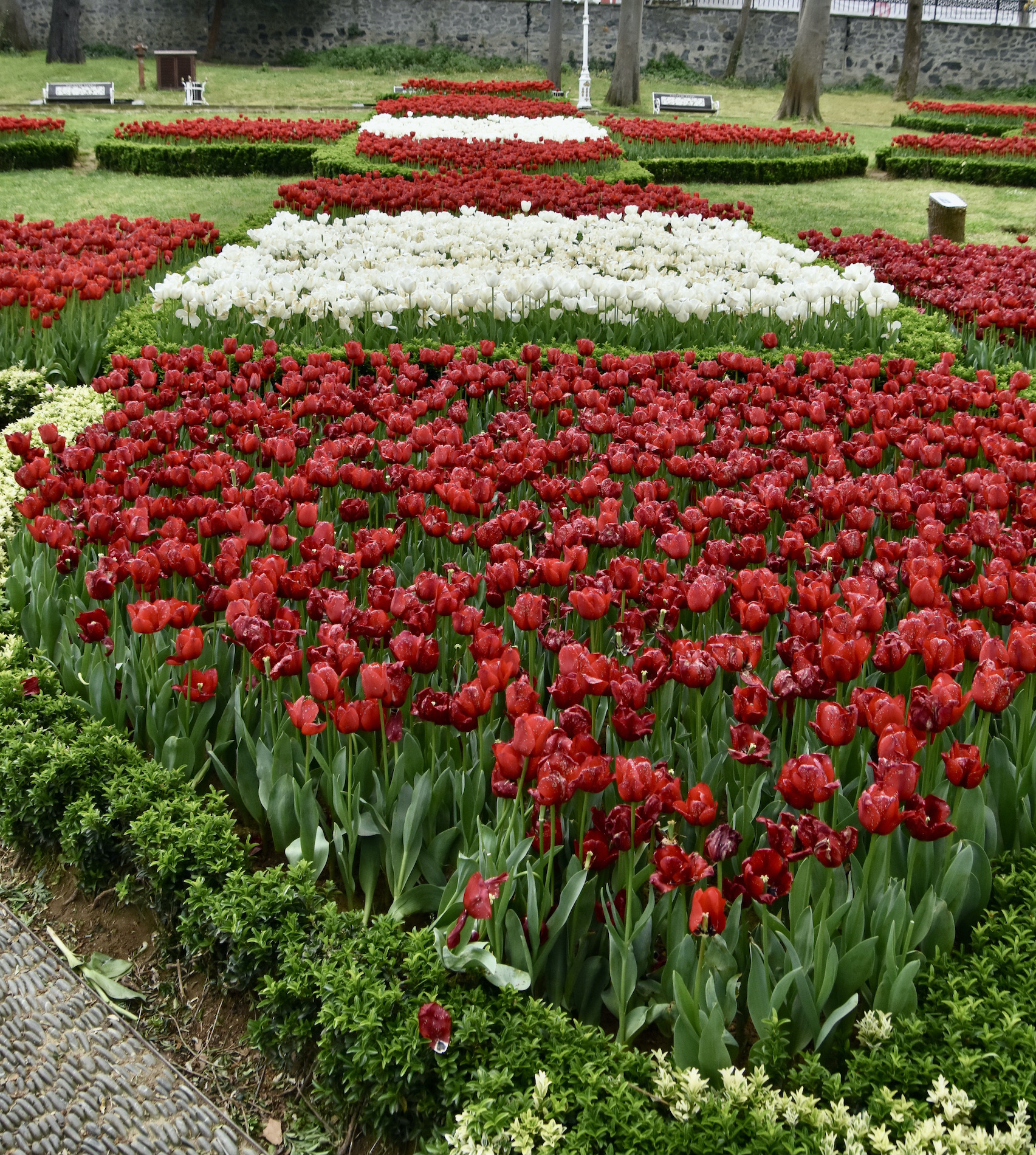
So we were well rested and ready to go when we met Victor and our nine other travelling companions, most of whom were Adventures Abroad veterans like us. We also met our local Turkish guide Ms Cigdem Girgic, whose name means crocus flower in Turkish and our driver Recgip who would be with us until we crossed the border into Greece. We had a large enough bus that everybody got a window seat and lots of room, but small enough to navigate some of the narrowest streets of Istanbul.

So let’s hop aboard and head for the Golden Gate.
Yedikule Fortress & the Golden Gate
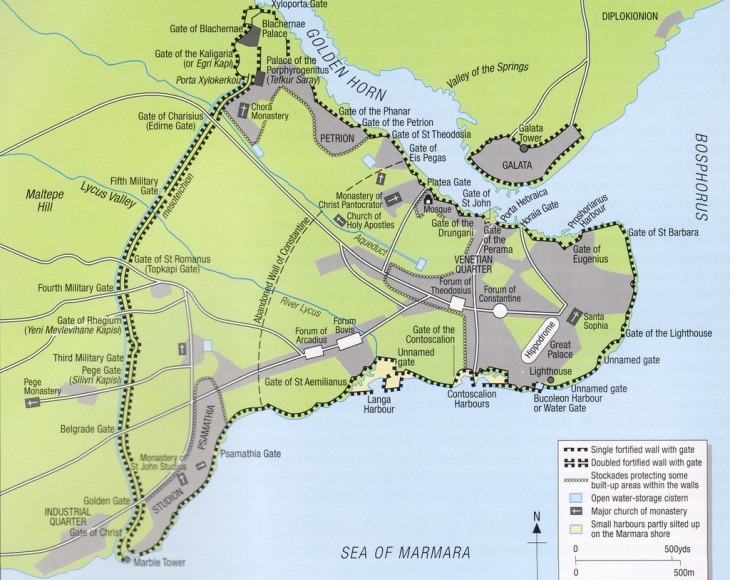
There was no city more famous for its walls in ancient times than those of Constantinople. Originally built by Constantine who founded the city on the site of the Greek city of Byzantium, the Emperor who built what we are going to visit today was Theodosius II and the walls often bear his name. The map above shows the extent of the walls around the entire city. On the landward side Theodosius had a double set of walls created with a moat in between and a guard tower every 170 feet. There were numerous gates of which the Golden Gate at the lower left side was the most important. It marked the end of the Via Egnatia so it’s a very apt starting point for this unorthodox Istanbul tour. It was also the royal gate, used only by the Emperor and a few honoured guests.
The walls protected Constantinople for over 1,100 years and resisted sieges on at least twenty occasions by Goths, Avars, Russians, Bulgars, Umayadds and three times by the Ottomans until finally the use of artillery proved too much and in 1453 the city fell to Mehmet the Conqueror. That did not spell the end of the wall’s utility as they remained intact for hundreds of years after the Ottoman conquest. In fact Mehmet built an entirely new fortress, Yedikule aka the Seven Towers beside the Golden Gate and had it walled up.
The fortress was the Royal Treasury for hundreds of years and also a prison where a number of foreign heads of state were executed along with rebellious pashas and other underlings. Gradually the walls began to fall into disrepair, the fortress abandoned and large portions were taken down. In the 1980’s the Turkish government began an extensive restoration project that continues to this day. The place was closed for a number of years and only reopened very recently. We will be one of the first groups to see it in some time.
We pull up to quite a small parking lot and just outside the walls are these two Ottoman houses, the one in the foreground completely restored and the one in the back in desperate condition. Cigdem advises that restoring dilapidated Ottoman houses is big business in Istanbul.
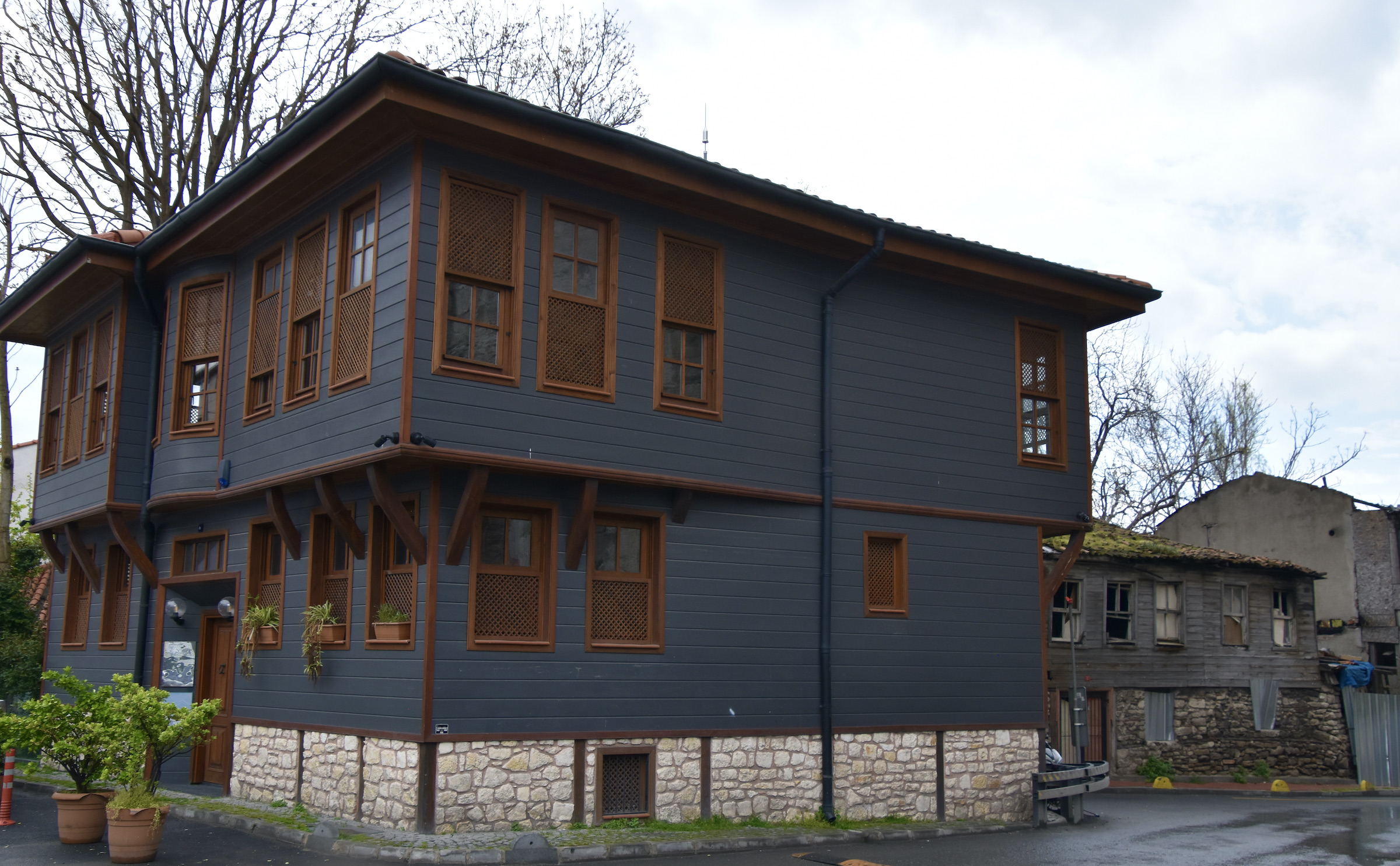
Opposite these houses loom the walls of Yedikule Fortress.
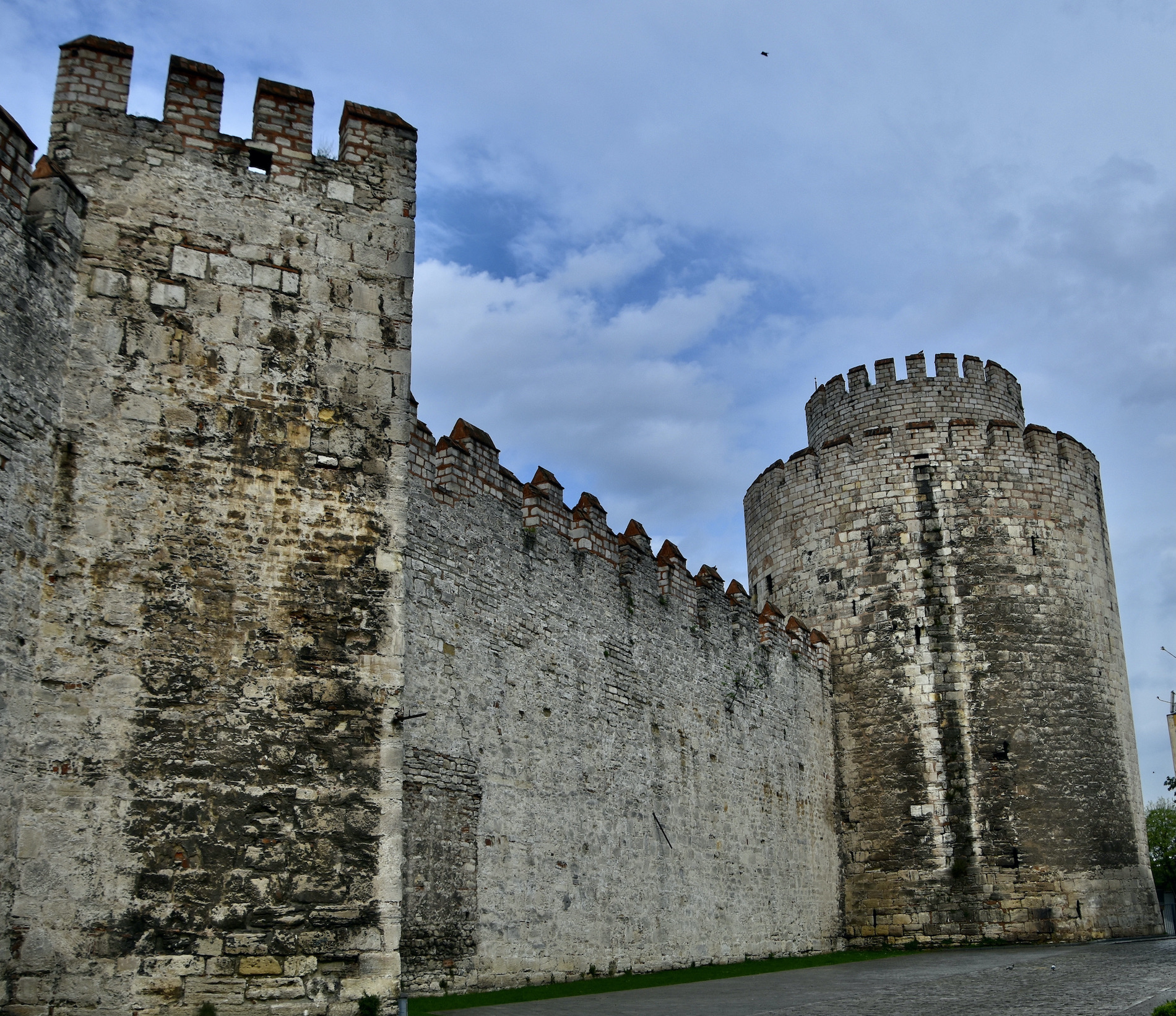
Inside there isn’t much to see except the walls themselves. I know from older posts done before the place was closed that you could climb up and walk the walls although it was quite dangerous. For now at least, the stairs going up are off limits. I’m OK with that because they are very steep with no railing. It would be a shitty way to start the trip with someone falling off the wall, so we’re content to stare and take pictures.
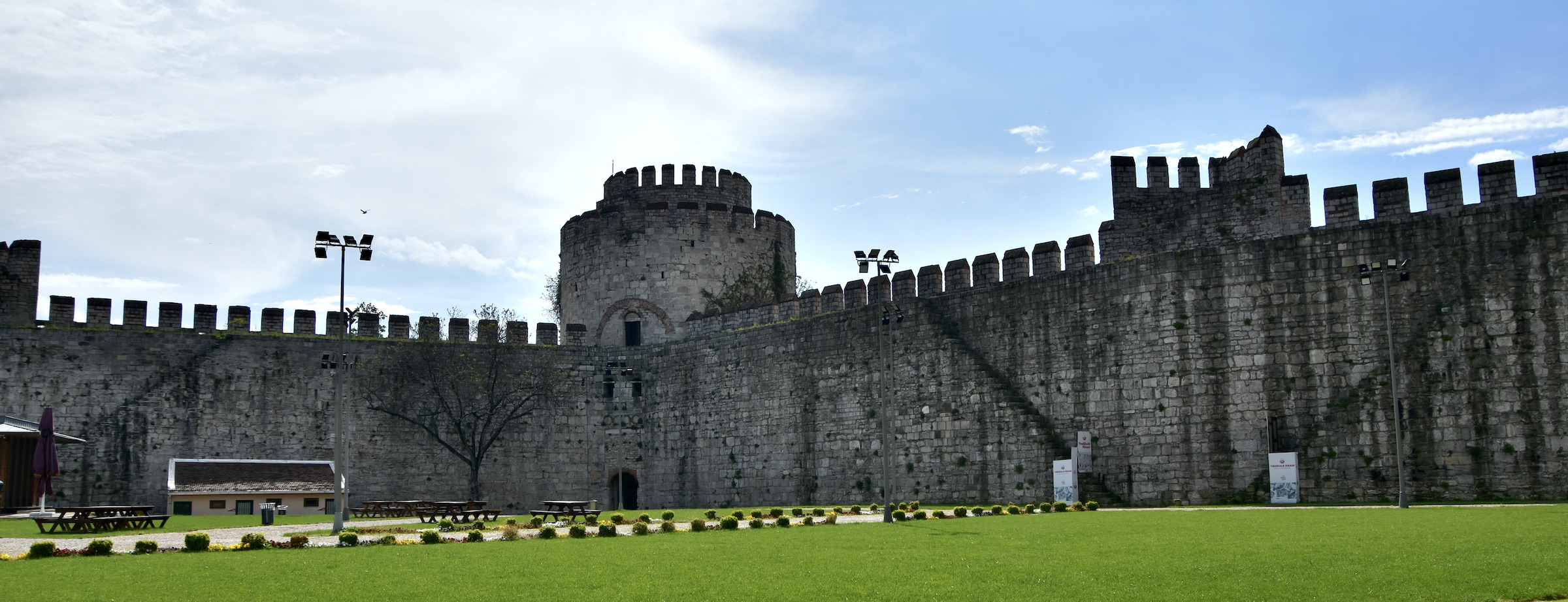
This door off its hinges is the entrance to the dungeon which is completely empty and pretty creepy.
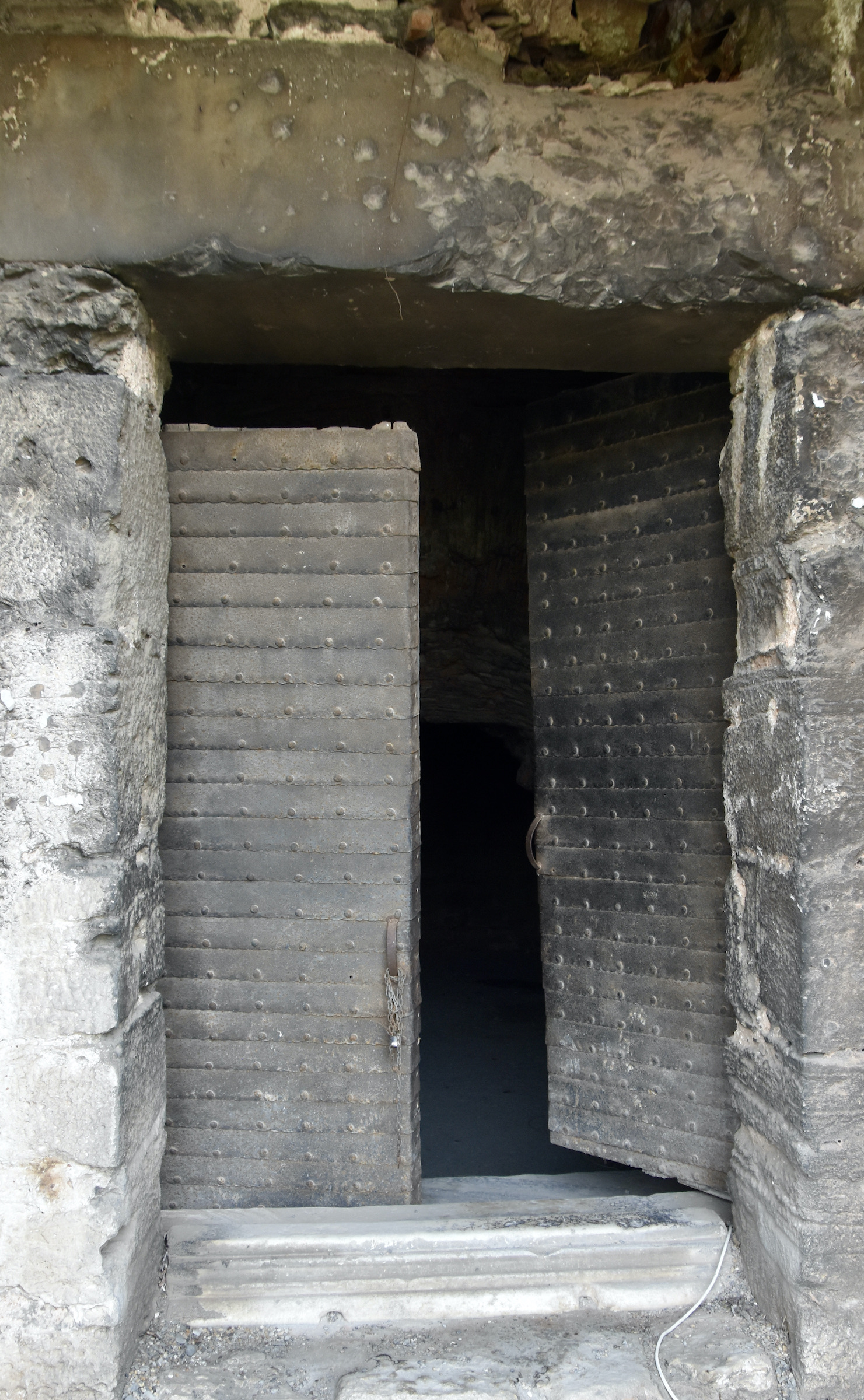
We came here on this unorthodox Istanbul tour to see the Golden Gate and the beginning/end of the Via Egnatia which we find outside of the fortress. Remembering that Theodosius had two sets of walls on the land side means there are actually two gates. This is all that is left of the inner gate.
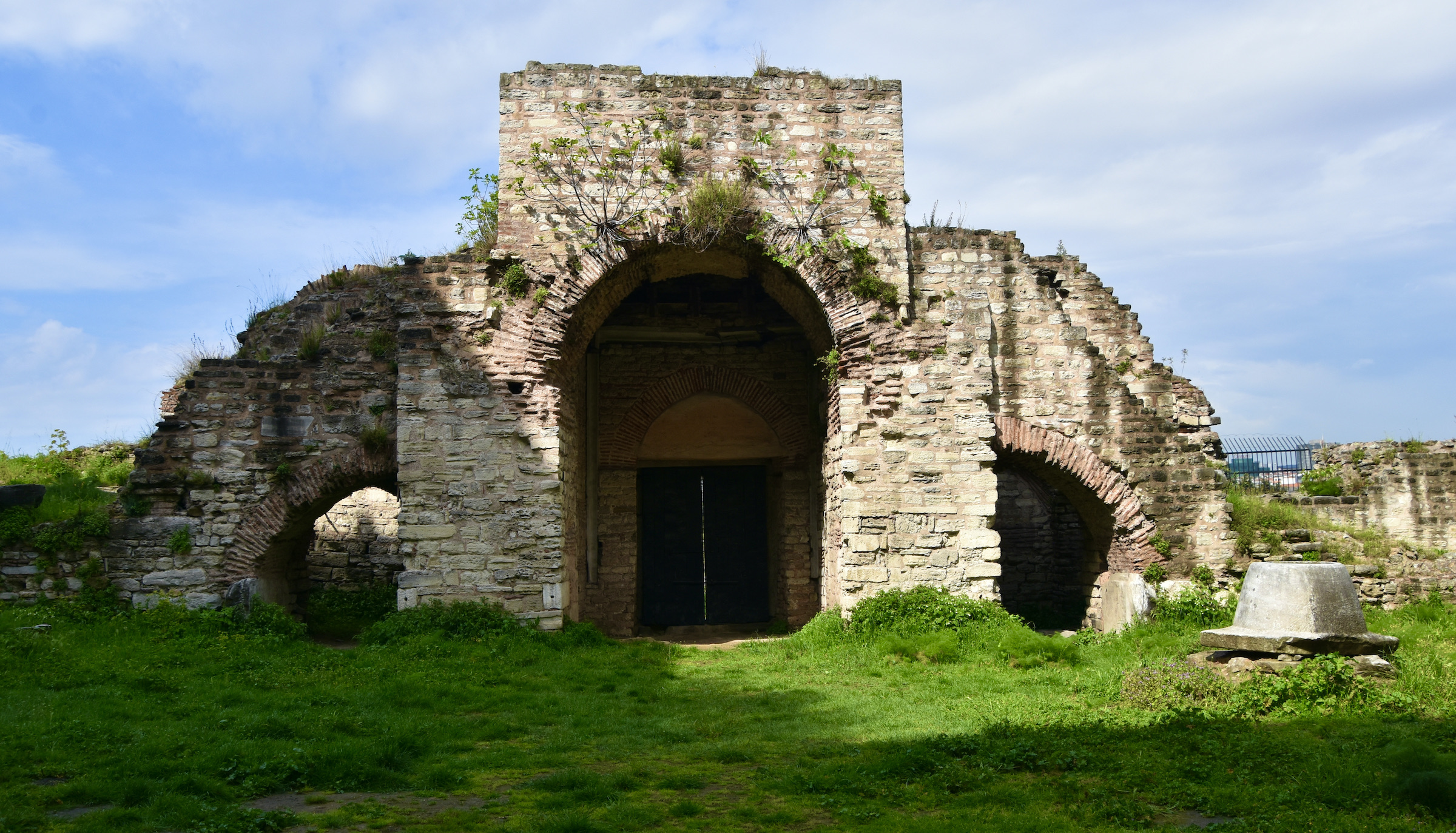
And finally the Golden Gate from the inside.
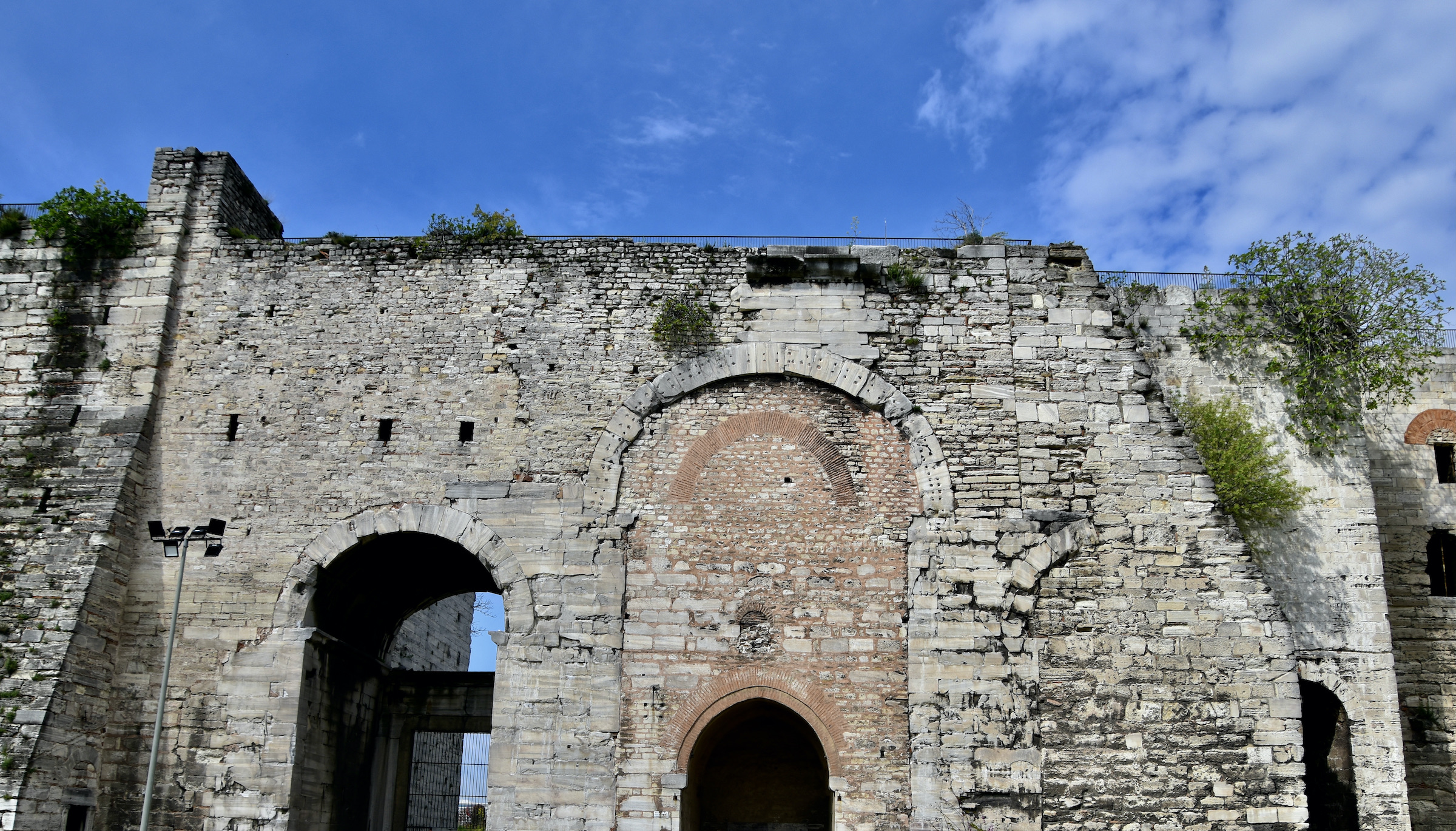
If you look closely you’ll see that it was once a three arched gate with the middle one much larger than the other two.
Passing through to the outside you can see this more clearly. It doesn’t look like much now and very few tourists bother to come here, but for me this is a longed for moment to see one of the most potent symbols of the Byzantine Empire. Would Constantine or Theodosius or any of the other 86 emperors have ever imagined their great gate would lie mostly in ruin, neglected and as forgotten as most of them are?
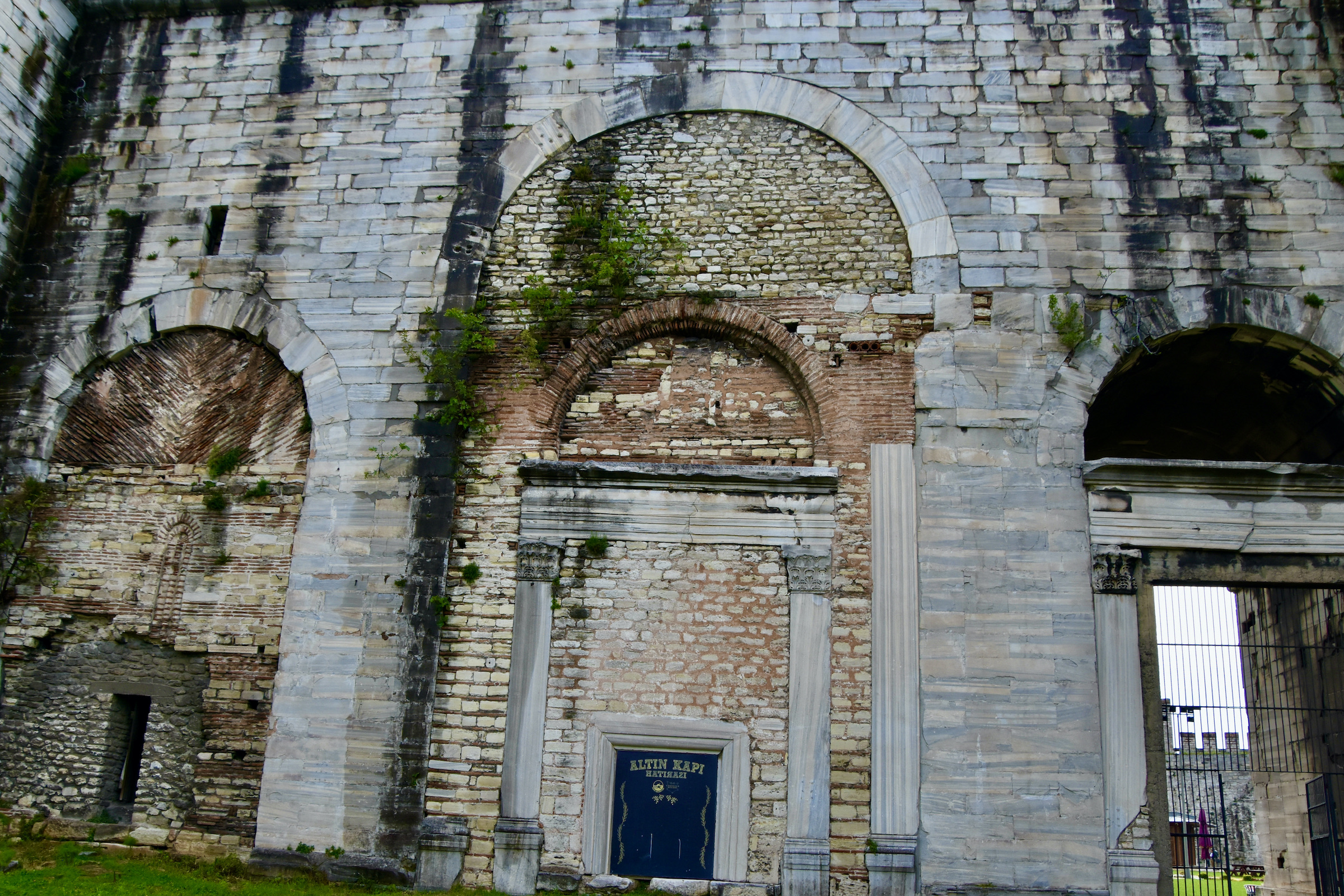
To give you a sense of scale we took a group photo in front of that dark door with the words Altin Kapi on it which is Turkish for Golden Gate.
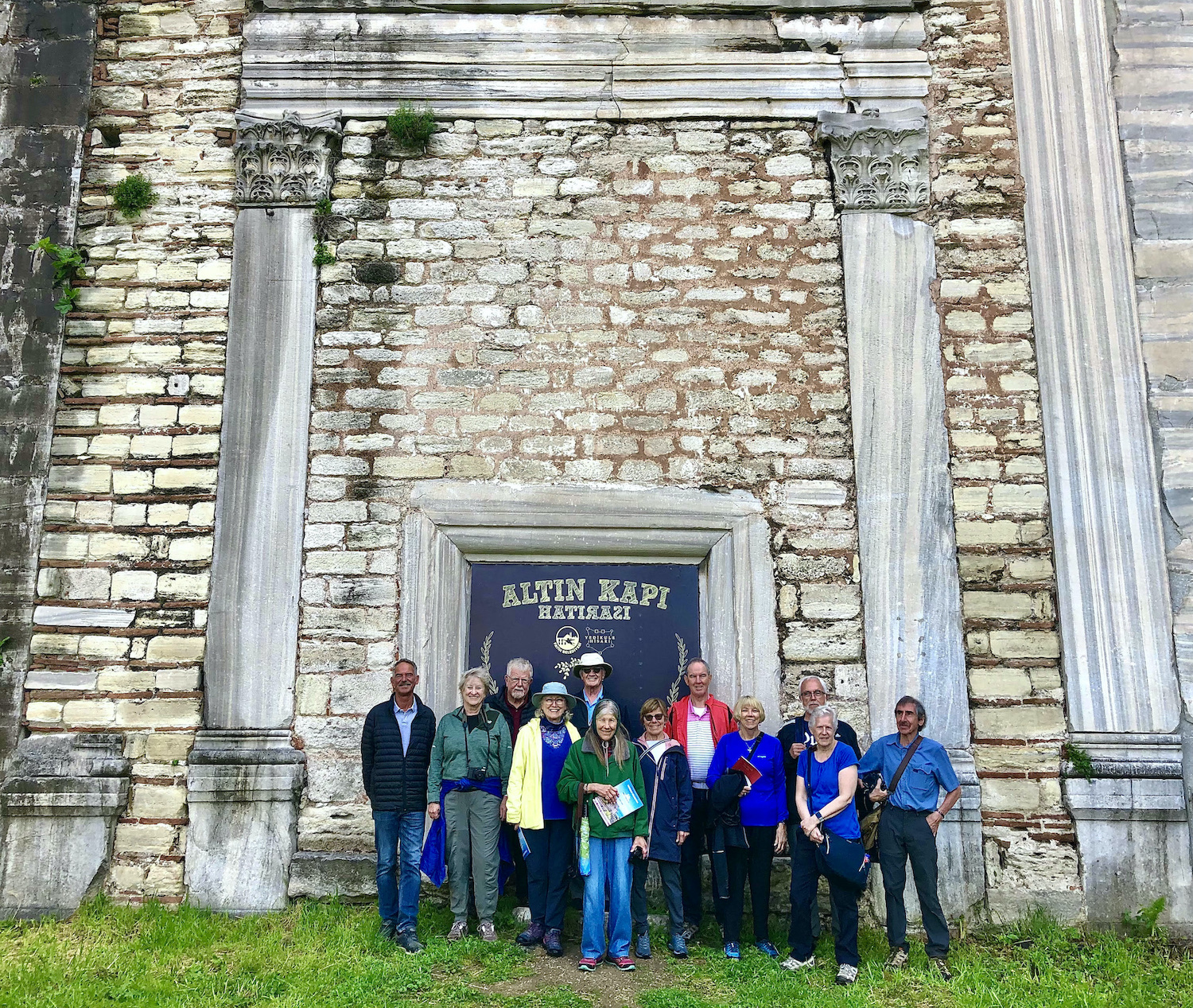
Tekfur Sarayi Museum
As with most first time tours, things don’t always go as planned due to unforeseen circumstances. Our second stop on the unorthodox Istanbul tour was to be to be at The Chora a Greek Byzantine church famed for its mosaics and frescoes considered to be the best examples of Palaeologian Renaissance anywhere in the Byzantine Empire. Alison and I had visited it some years earlier and were so impressed I wanted it included in the Via Egnatia itinerary. After the conquest of Constantinople it was converted to a mosque and the interior artwork was plastered over and it stayed that way for centuries. In 1945 it was declared a museum and after three years restoration work undertaken with American funds, in 1948 the mosaics and frescoes were seen for the first time in 500 years. All was well until Turkish Islamists got into the act. After their successful campaign to have Hagia Sophia converted from a museum to a mosque, The Chora became their next target. In 2020 it was converted to a mosque which would not have been too drastic if the artwork remained on display and that is what I was expecting. But then, without warning it was abruptly closed to the public and no one knows what is going on inside, but the best guess is that those mosaics and frescoes are once again being desecrated in the name of religion. The same people who scream ‘Islamaphobia!’ at even the slightest hint of criticism should look in the mirror and recognize that what they demand is exactly that, yet aimed at Christianity. I am no Christian or anything for that matter, but these conversions have caused great distress to the Greek Orthodox community and Greece in general for no good reason other than pandering to extremists.
So we’re no going to The Chora, but rather another recently opened museum nearby. If you look at the map of the walls you’ll see the Chora in the upper half right where the land walls meet the Golden Horn. After leaving Yedikule Fortress we followed the course of the walls towards the Golden Horn, getting a look at The Aqueduct of Valens along the way.

After turning down some really narrow side streets we pulled up at Tekfur Sarayi Museum which is a newly restored Byzantine era building once known as the Palace of Porphyrogenitus after the emperor of that name. This is a photo of the exterior taken from the museum’s website.
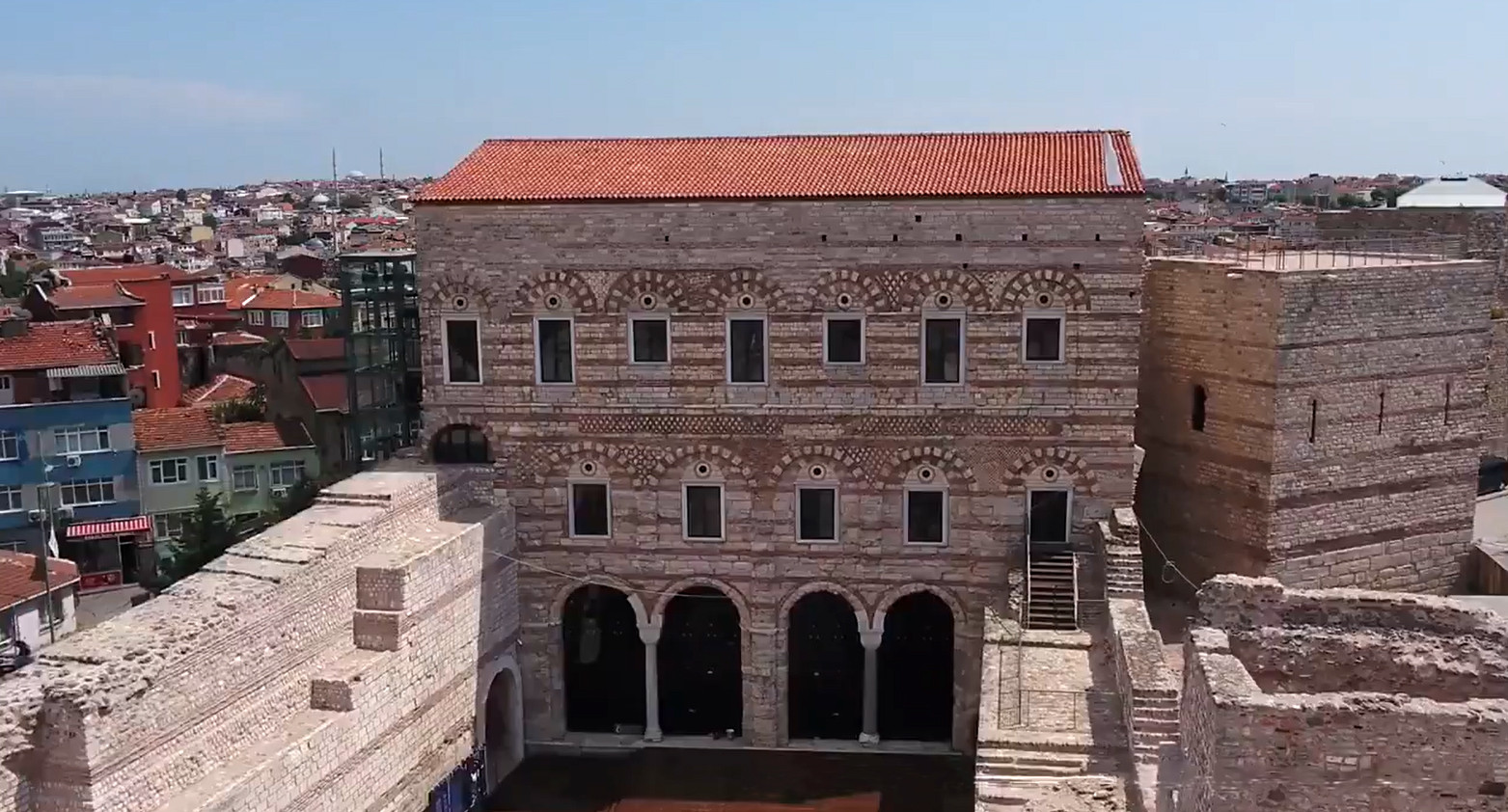
It’s an impressive building to be sure, but we were not here to see the museum per se, but for two other reasons. The first was to see a digital version of the murals and mosaics that we could not see at The Chora. You can view each of the panels and get details that you might not know on an in person visit, but frankly this sop, just made me angrier at what was being done to the originals.
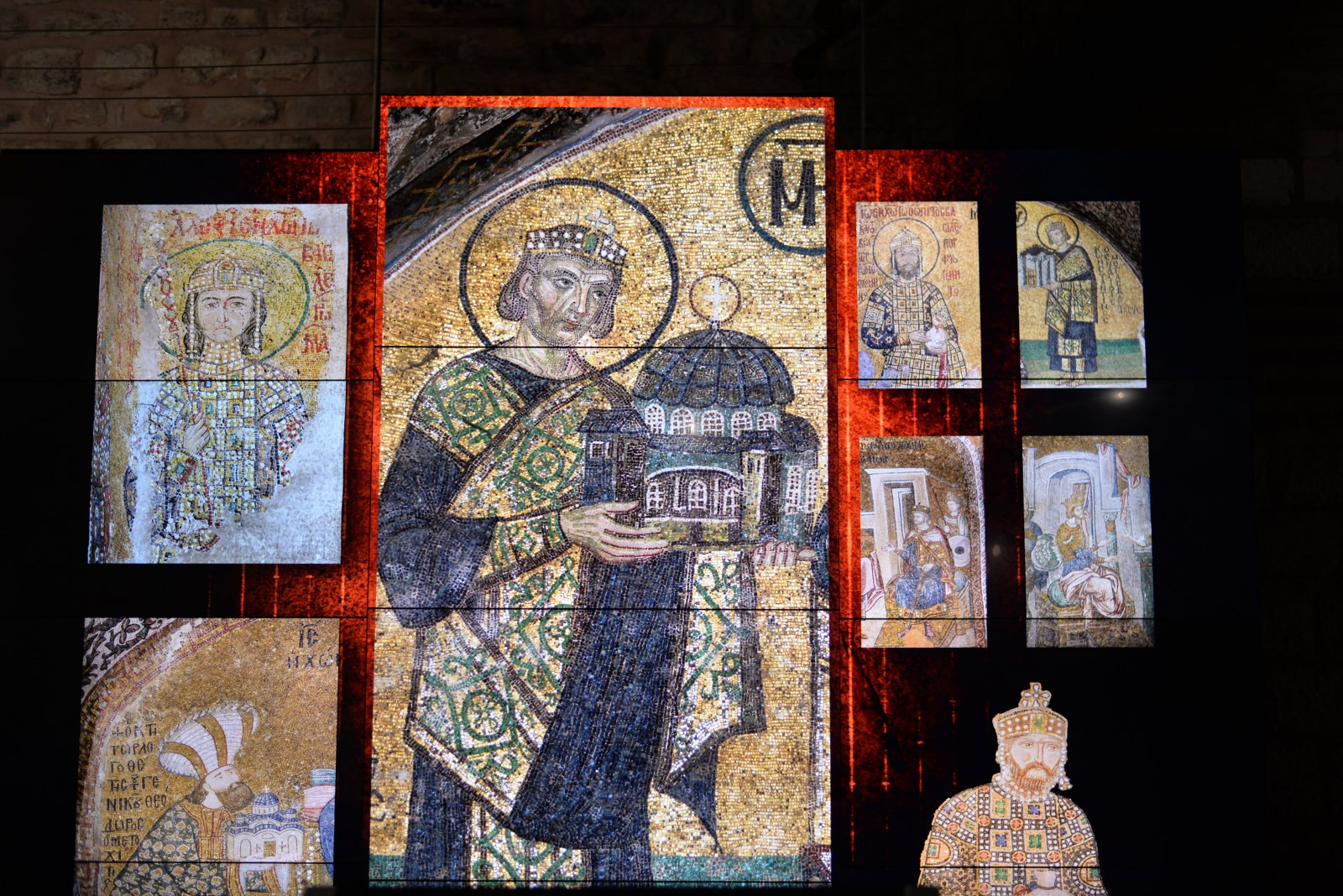
The other reason for stopping at this place was to climb up to the roof which is directly connected to the ancient walls. Here you can get a clear view of the walls and their intermittent guard towers.
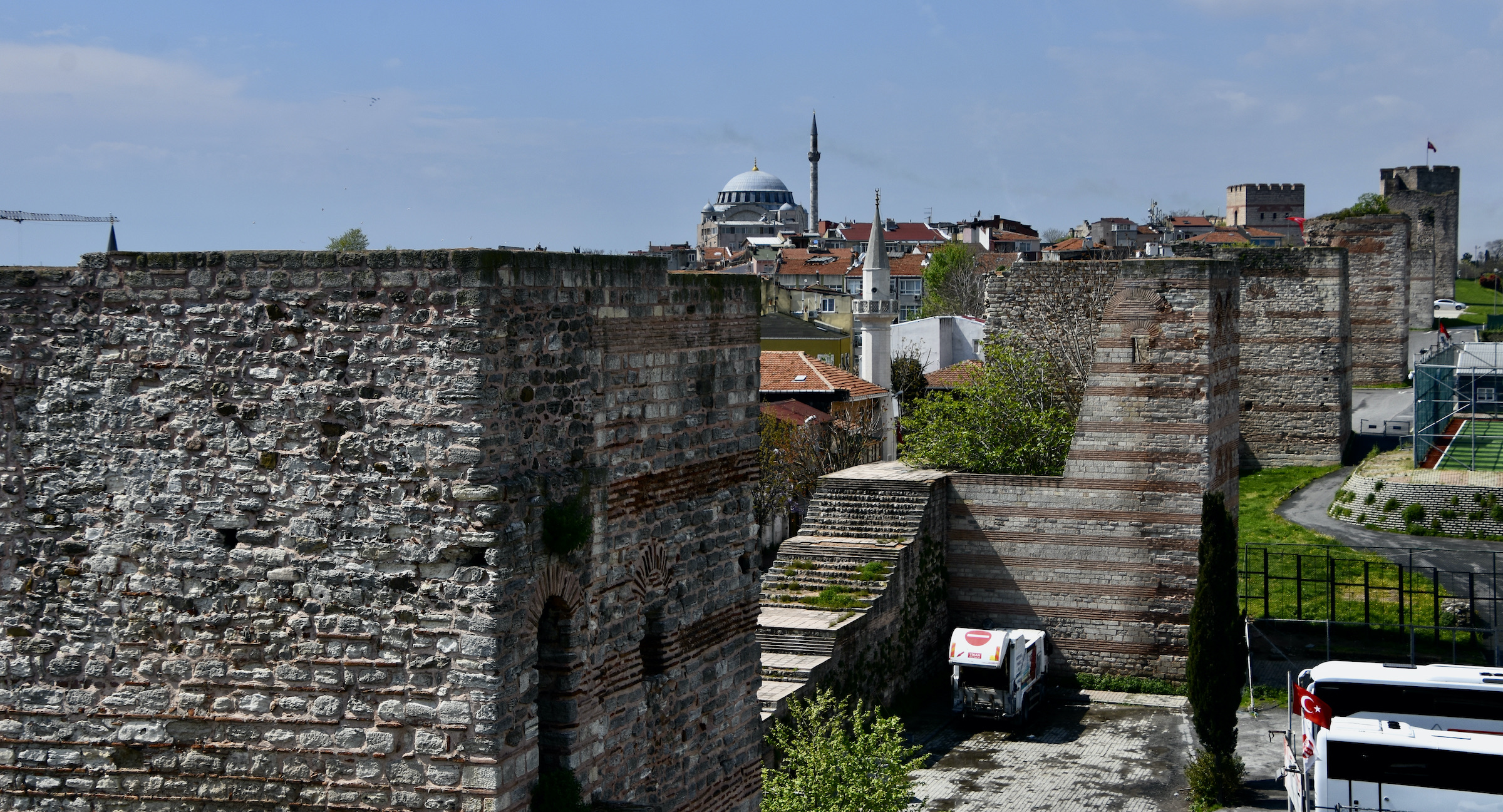
You can also get a great view of the city from one of the highest points in the old part of the city. This is looking down at the Golden Horn bridge which we will be crossing shortly.
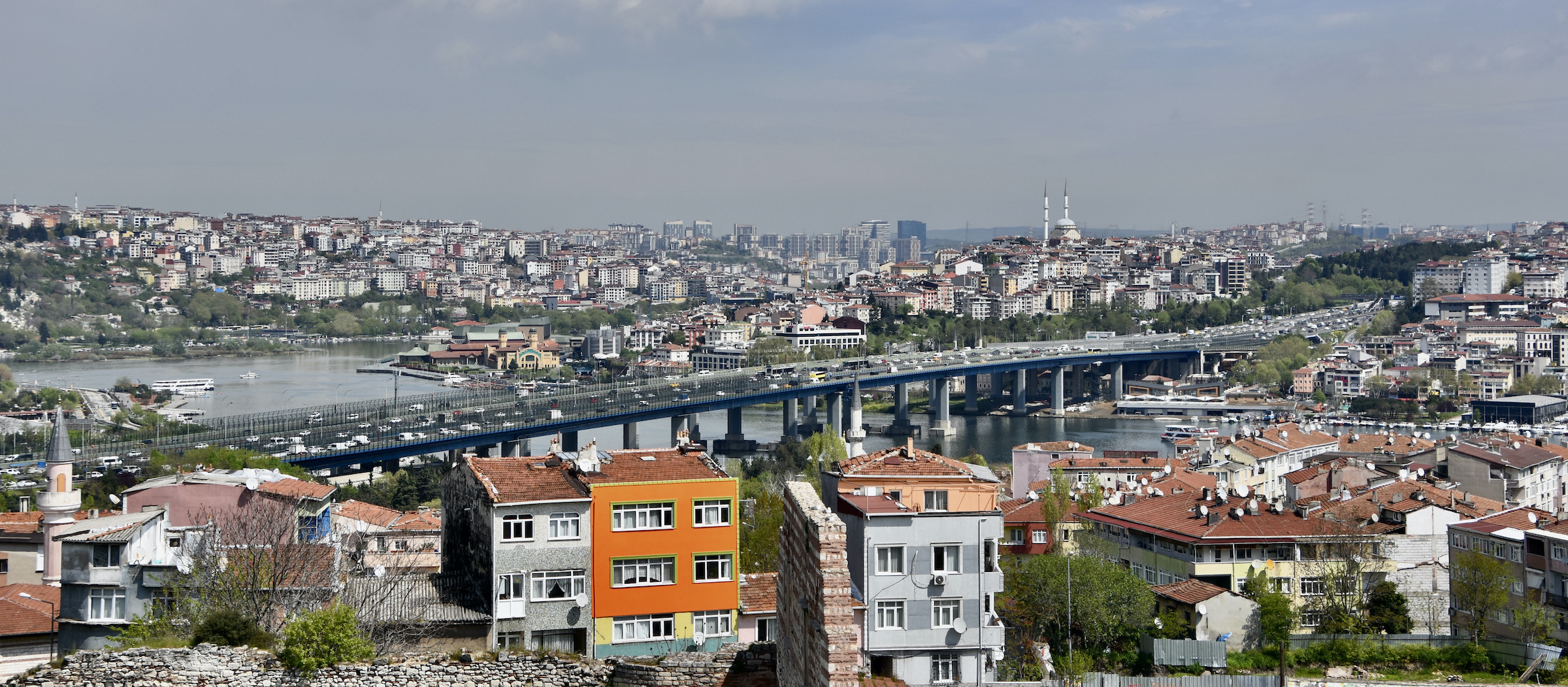
Looking in the opposite direction you get a contrast of old Istanbul right below you and modern Istanbul in the distance.
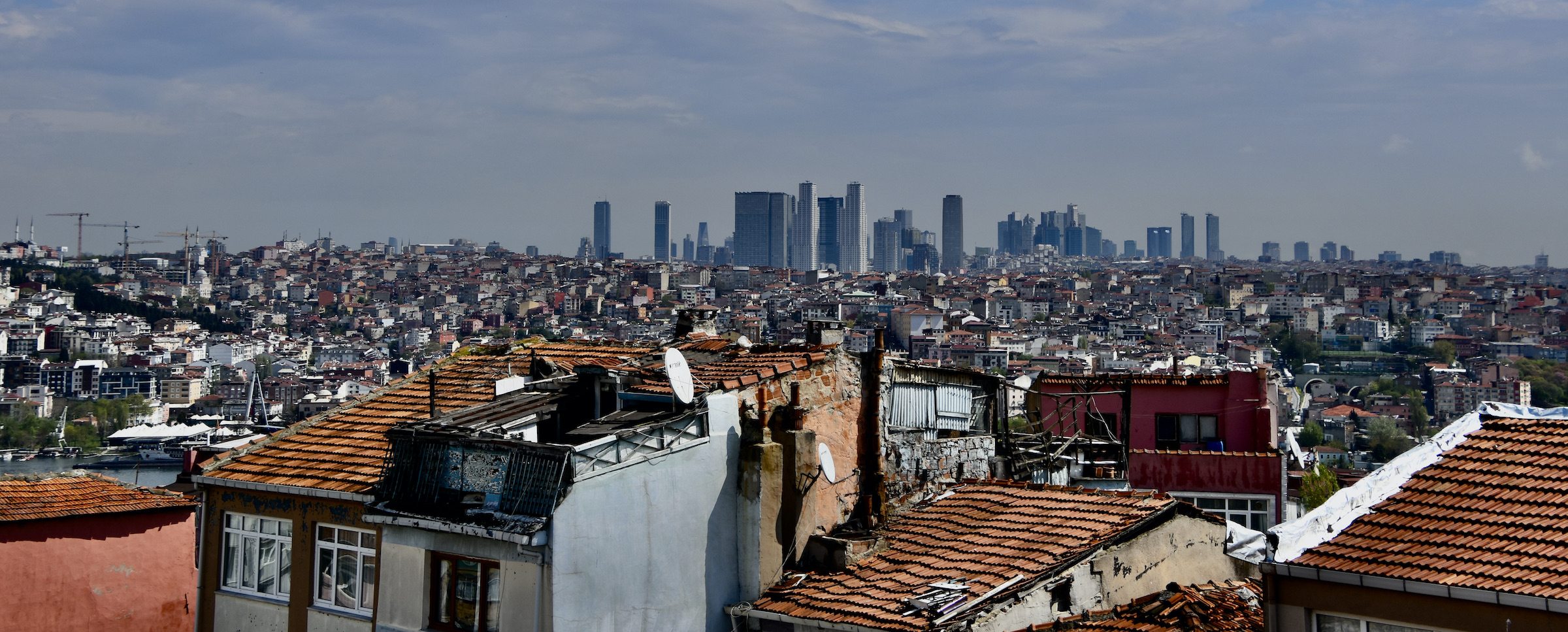
Unorthodox Istanbul – Galata
It was now time to leave the city walls and take our unorthodox Istanbul tour across the Golden Horn to the Galata district which is remarkably different than the Istanbul found within those city walls. If you look at the map above once more you’ll see that there was another much smaller walled area called Galata which was actually a colony of Genoa from 1273 until the conquest in 1453. Often referred to as ‘European Istanbul’ the architecture here has definite western influences more so than Ottoman. Cigdem led us on a walk through a number of pedestrianized streets on the way to the most famous building in Galata, the tower of the same name. We passed by the Pera Palace Hotel on the way. This art nouveau classic was the starting or ending point for travellers on the Orient Express and is like something straight out of an Agatha Christie novel and if you’ve got enough money you can stay in the room where she is alleged to have written that famous book. My choice would be to opt for the Ernest Hemingway suite, but others can chose from rooms once occupied by Jackie Kennedy, Greta Garbo, Mata Hari or Alfred Hitchcock.
Not far past the Pera Palace our next destination came into the site, the Galata Tower which was built by the Genoese in the 14th century and has been one of Istanbul’s most famous landmarks ever since. Completely restored in 2020 it is once again welcoming visitors after being closed for some time.
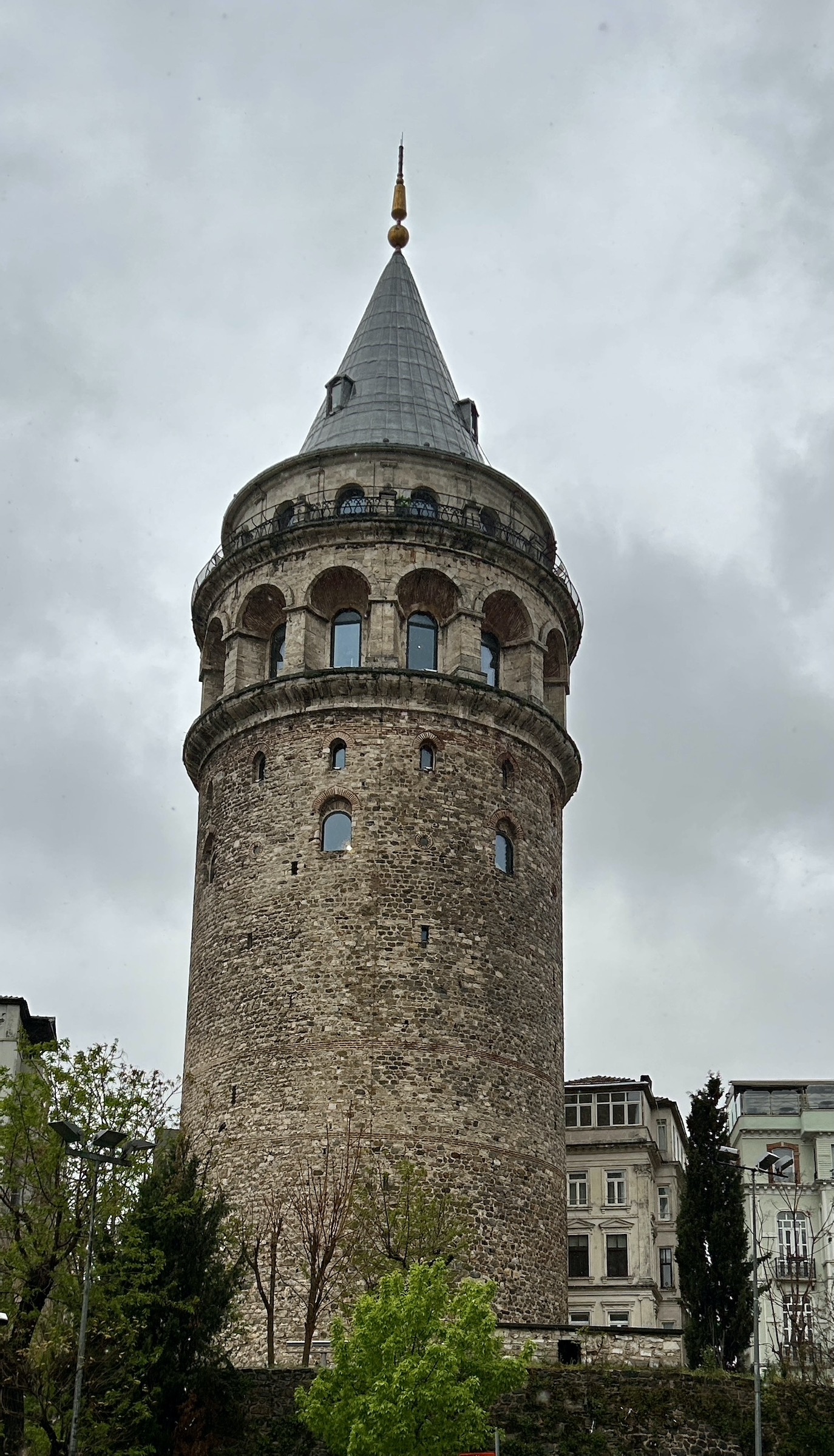
We took the elevator to the second level from the top where there is this wonderful map of the city.
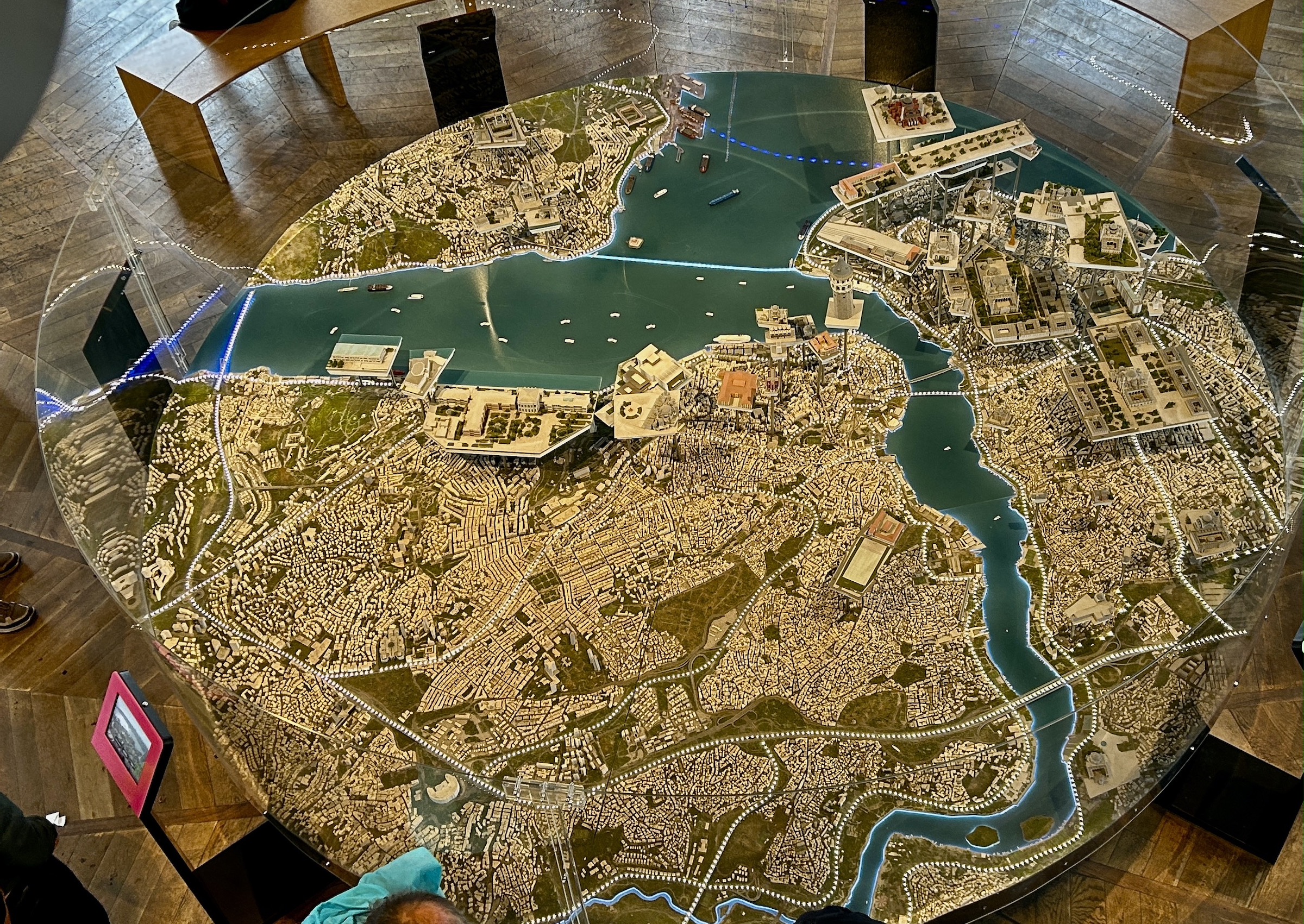
From there we climbed the spiral staircase to the highest level where you can walk outside and get an unobstructed view of Istanbul. It is one of the highlights of visiting the city, but one most tourists who don’t leave the Sultanhamet area, miss. This is looking across the Golden Horn to the Sultanhamet with Hagia Sophia, the Blue Mosque and Topkapi visible in the distance. Unfortunately there was a rainy spell during our visit, but usually it’s much clearer than this.
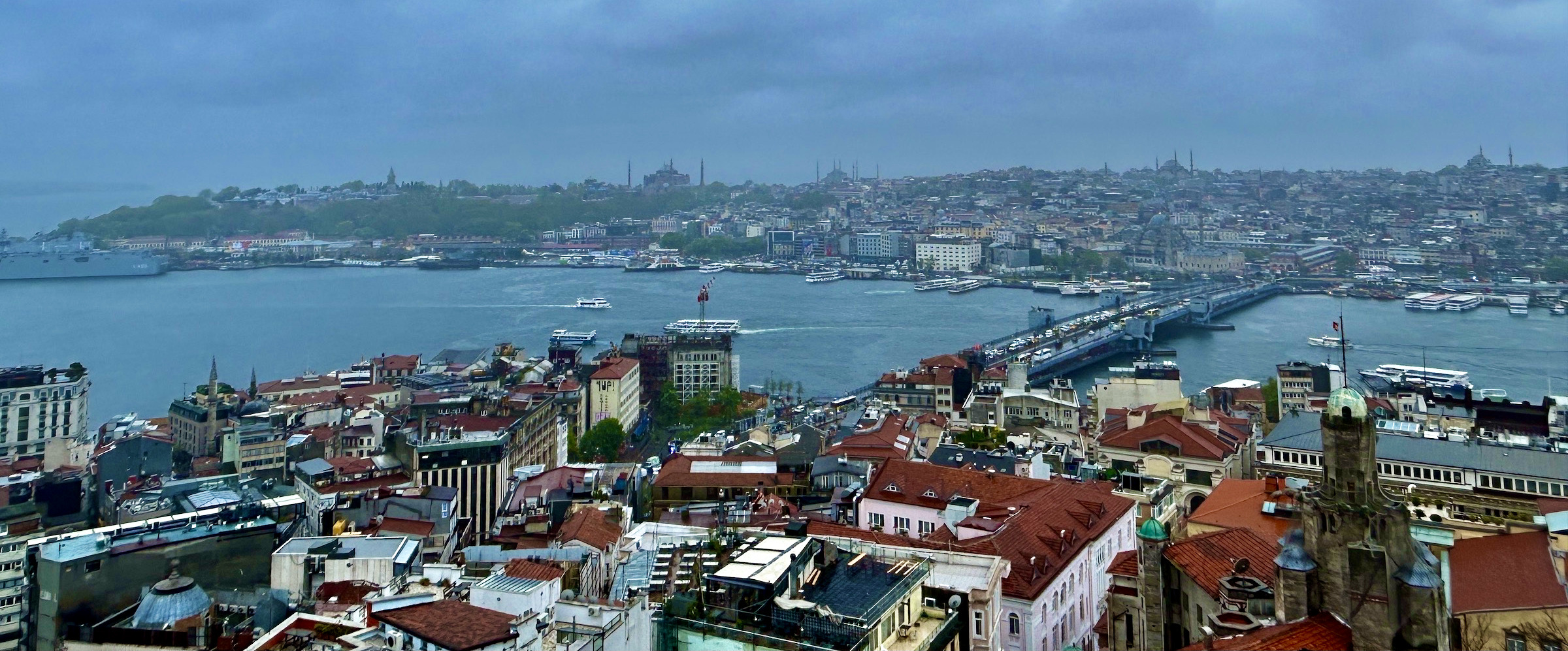
The Galata Tower was also the site of one of the most unusual and daring feats that any one man has ever pulled off and that is now commemorated in this interactive audio-visual display.
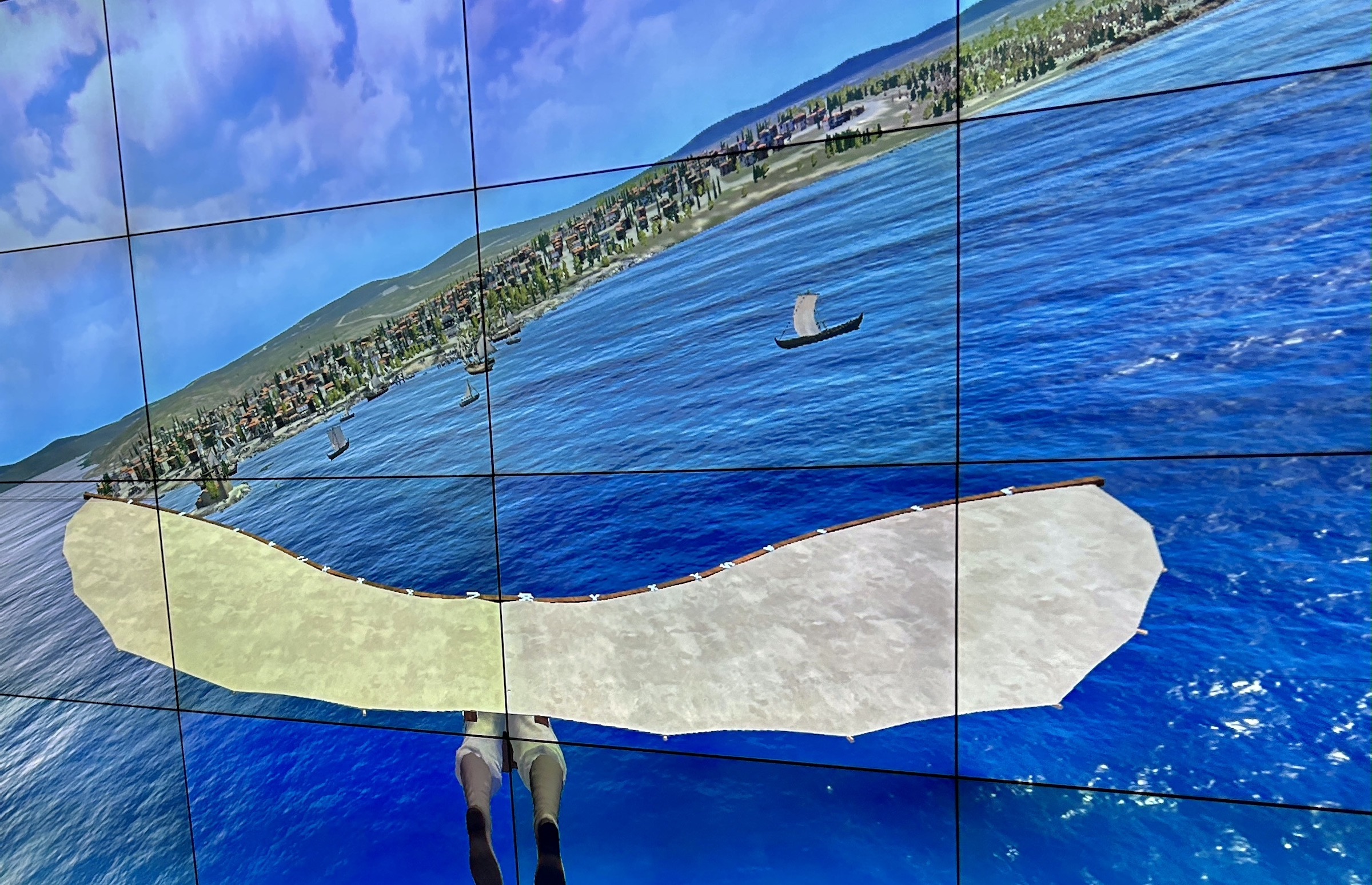
Apparently inspired by the drawings of Leonardo da Vinci, in 1632 one Hezarfen Ahmed Celebi, a man known for his scientific knowledge of flight, jumped off the Galata Tower with wings as shown above and successfully glided 3,558 metres (2.21 miles) across the Bosphorus. You can recreate his amazing flight with this free simulation that really brings home to you how insane this man was to try this in the first place. The thanks he got from the sultan was to be banished to Algeria for being a ‘dangerous man’. Of all things on this unorthodox Istanbul tour, this feat is definitely the most bizarre.
Instead of taking the elevator back down you go down this really neat winding staircase.
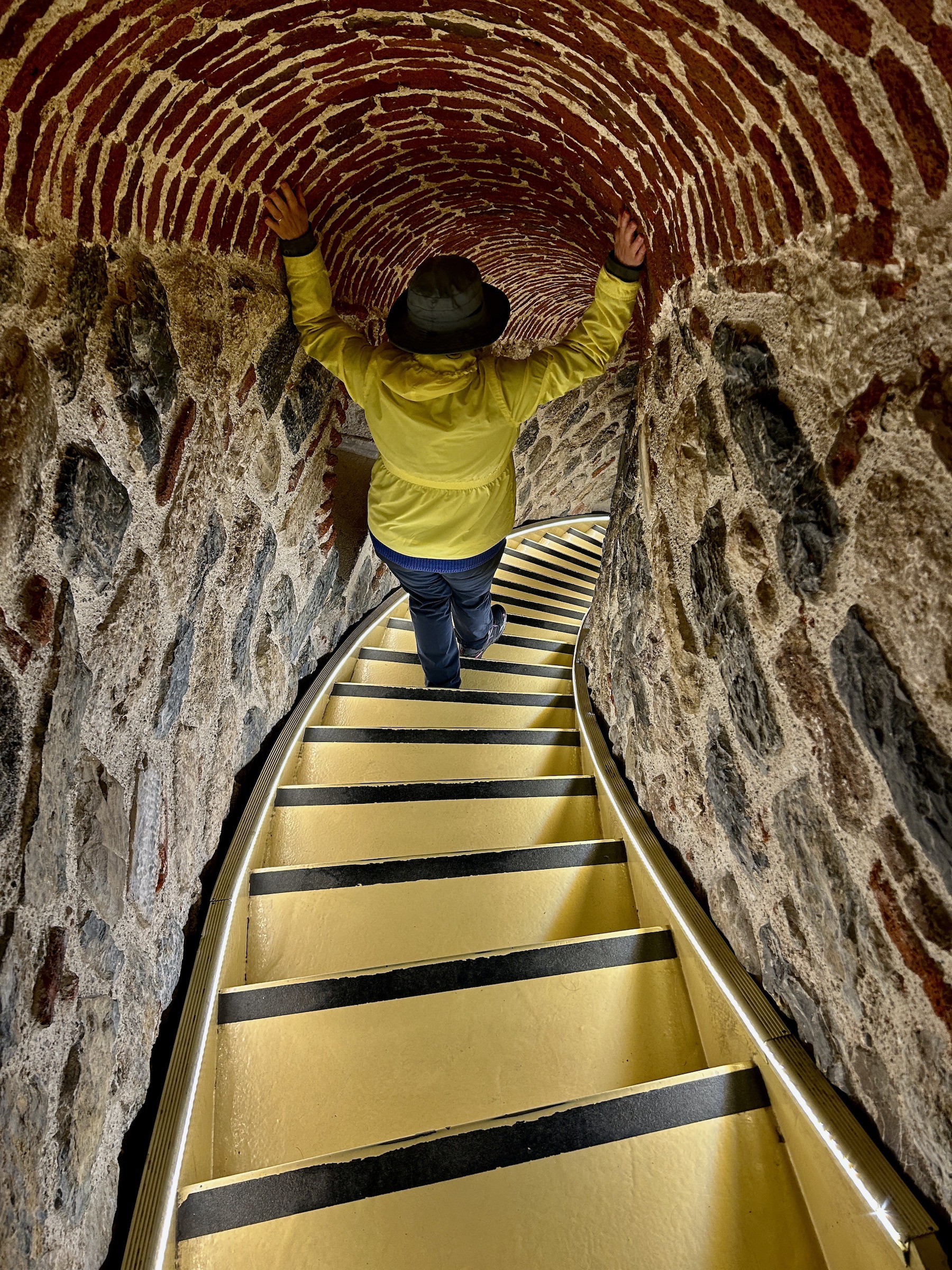
We now reboarded our bus and crossed over the Golden Horn to visit a most unusual church and take a stroll in one of Istanbul’s most interesting neighborhoods.
Unorthodox Istanbul – The Balat District
While from my description of what the Turks were doing to The Chora you might think there are no Christian churches in Istanbul, there are some. In fact, the most important member of the Eastern Orthodox Church, the Ecumenical Patriarch of Constantinople, is still based here. Also holding the title of Archbishop of Constantinople the current Bartholomew I is the 270th person to hold that distinction. He is also the only person who has jurisdiction over the monasteries of Mount Athos, Greece some of which we will see later on this tour. Not surprisingly the relationship between the Ottomans and their successors the modern Turks has not been without difficulty for the patriarchs. Several were executed including Gregory V who was lynched on Easter Monday when the Greek rebellion broke out in 1821. Today the patriarchy is tolerated by the Turkish government, but with the stipulation that the patriarch must be a Turkish citizen of Greek descent. Considering that most of the Greeks were expelled during the great exchange of 1923 the number of candidates is pretty small. This is yet another matter of continuing friction between the two countries of which there are more than a few as I will document in upcoming posts.
Up until the conquest of 1453 the patriarchal church was Hagia Sophia. Since then, it is in the relatively modest St. George’s Cathedral in the Phanar district of Istanbul which was once the centre of the Greek community of the city. Cigdem points out the place as we drive by on our way to our next stop which is also a church.
This is St. Stephen’s Orthodox Bulgarian church which is despite its name is a fitting stop on the unorthodox Istanbul tour. What’s so different about this structure which at first glance looks like just another stone church? Except it’s not. It’s one of the few remaining churches in the world made of pre-fabricated cast iron. The pieces were cast in Vienna and shipped to this site on the Golden Horn where they were assembled into what you see today.

This is the altar as seen from the second story balcony.
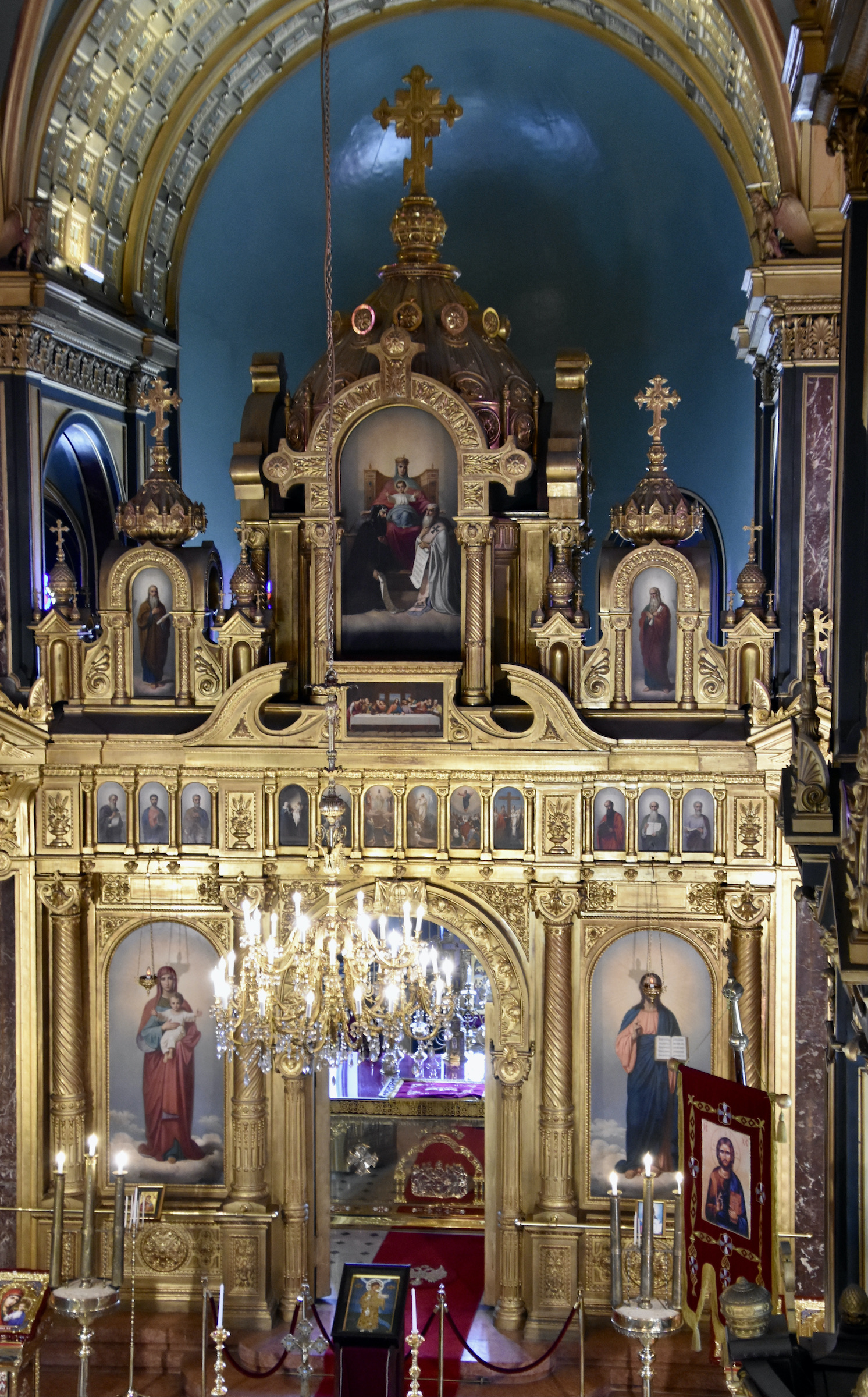
Leaving the church grounds, Cigdem leads us on a walking tour of the Balat neighbourhood which was once the Jewish enclave of Istanbul, but is now one of the chicest areas of the city with narrow streets, open air cafes and interesting shops.
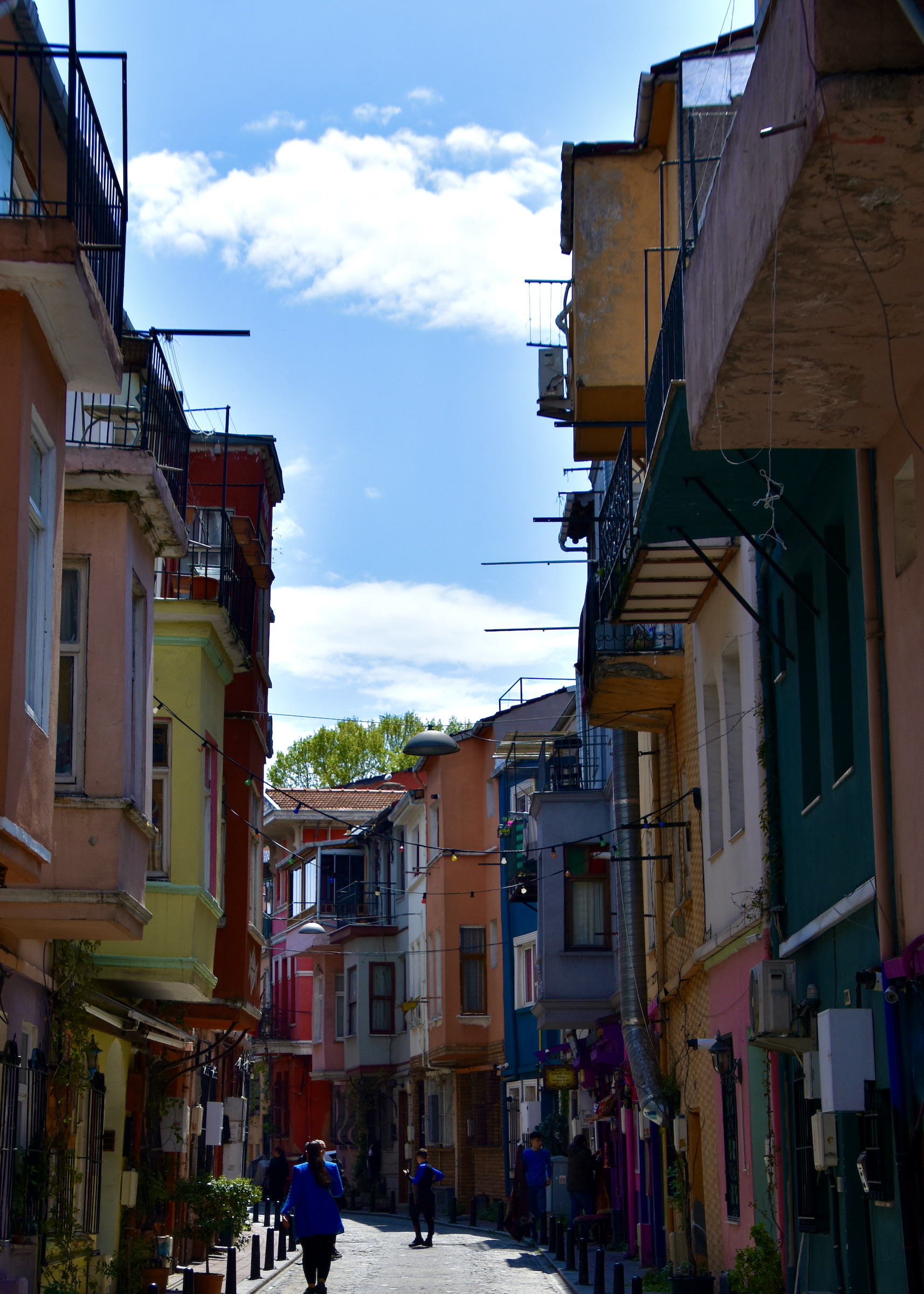
There are great examples of Ottomon architecture in this vibrant, but not too touristy neighbourhood.
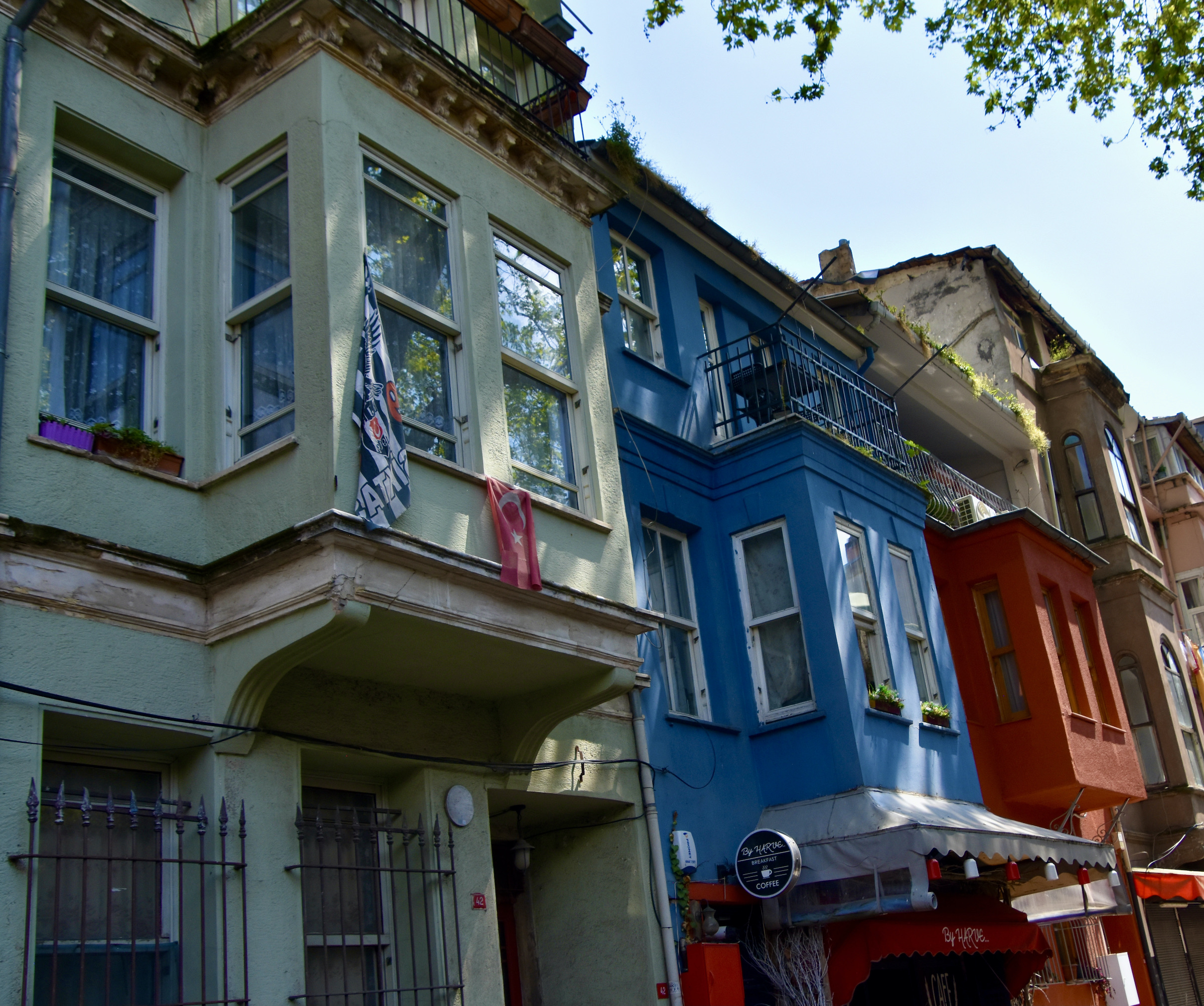 Ottoman Balconies, Balat
Ottoman Balconies, Balat
This was the first time Alison and I had been to this area of the city and we found it was really fun to explore without the hordes of people in the Sultanhamet.
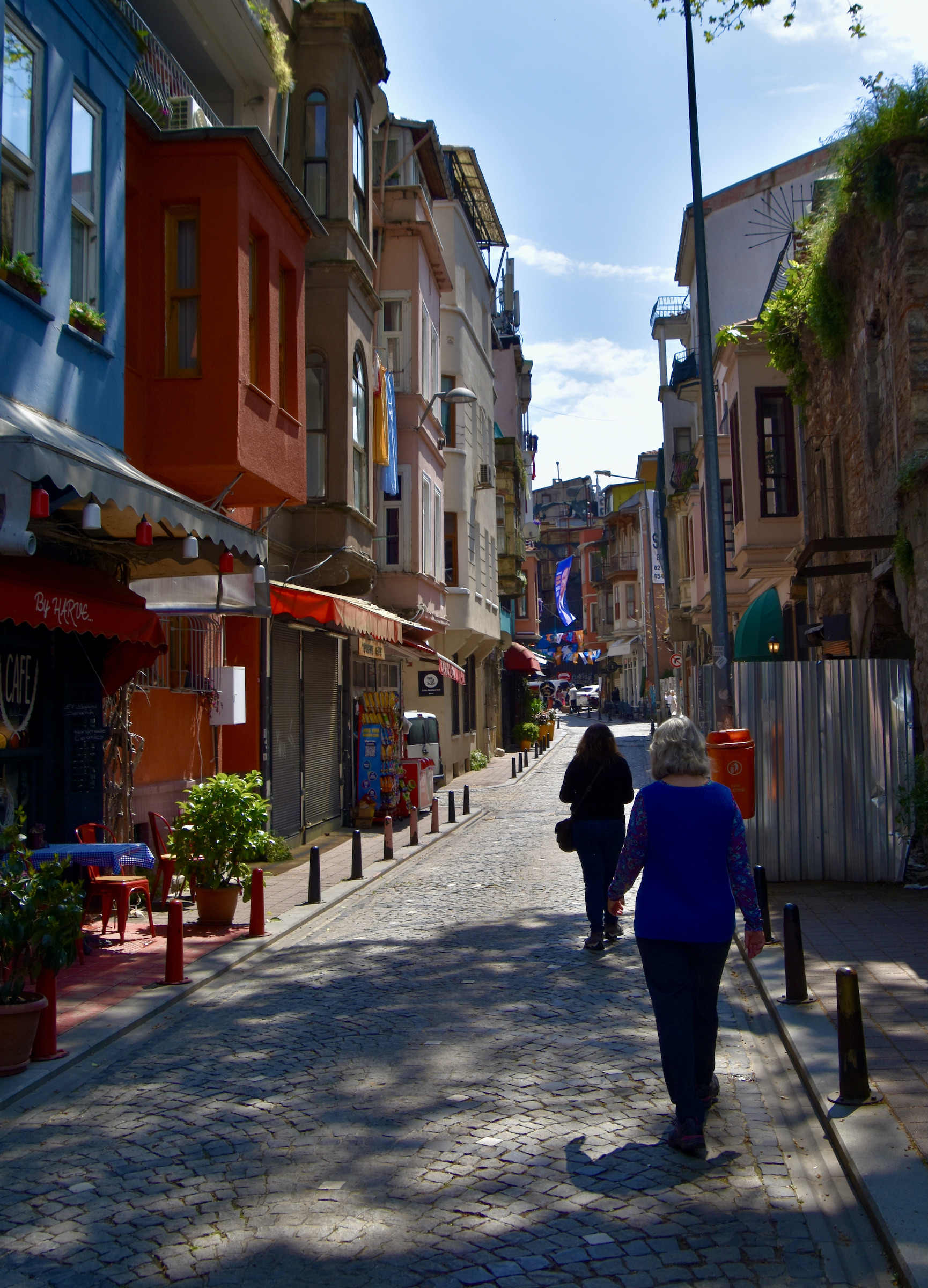
Although it appears flat from the preceding photographs, parts of Balat are quite steep and the colourful houses reminded me of Jellybean Row in St. John’s.
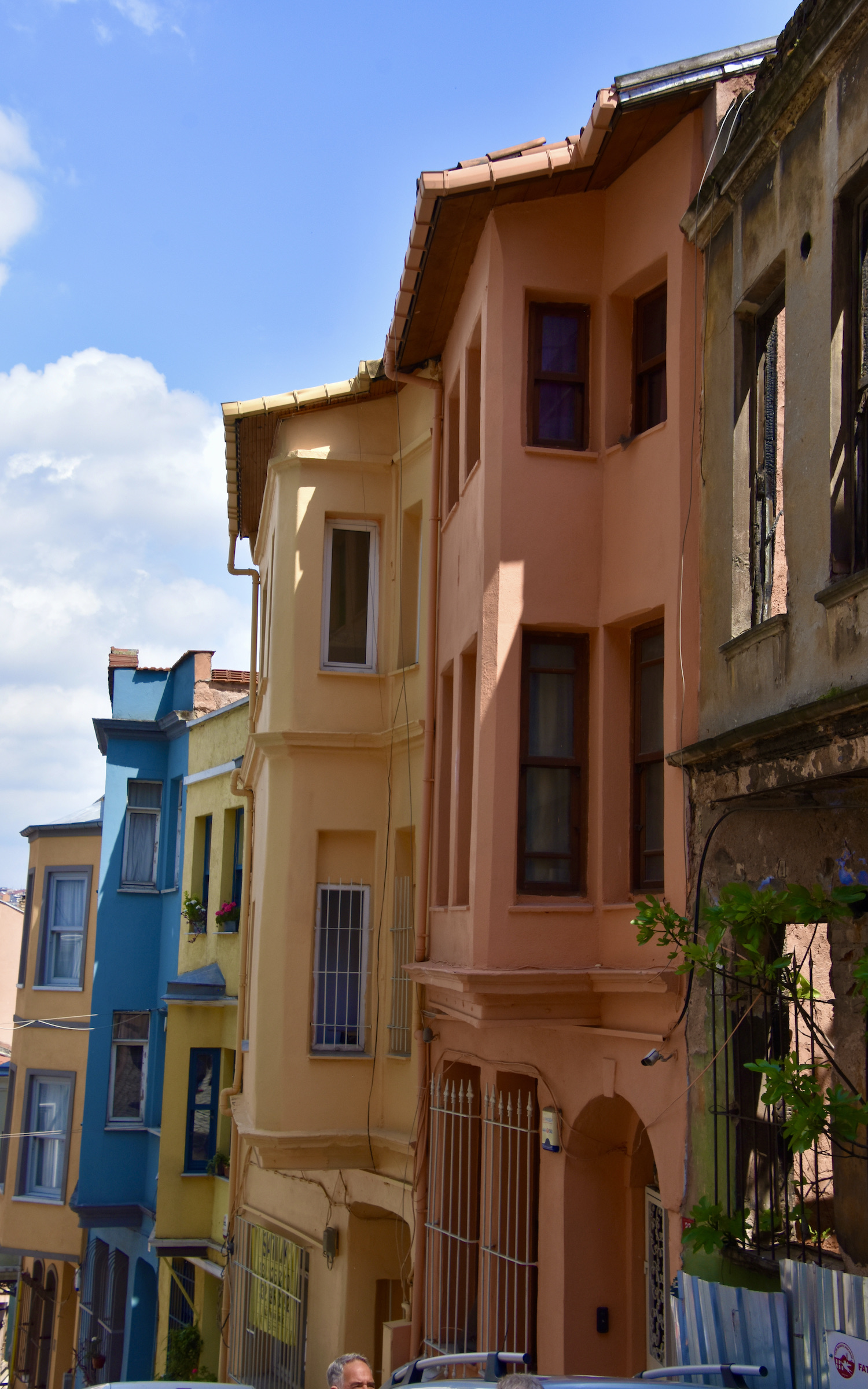
Near the top of this street is the Hogwarts of Istanbul, the Phanar Greek Orthodox College which has roots going back to 1454, the year after the conquest. This building, known locally as The Red Castle, dates from 1883 and continues to operate as a private boarding school today.
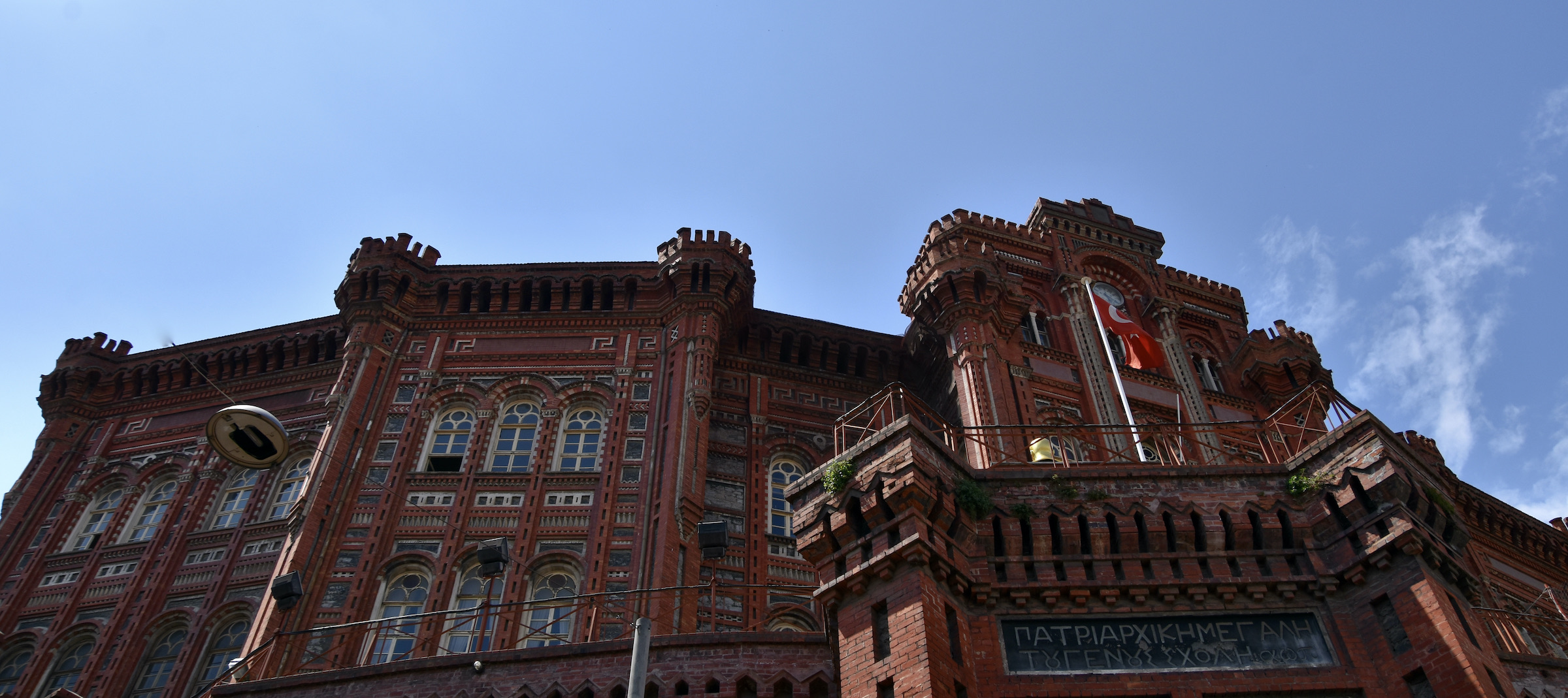
Heading back down the hill I stop to look at these interesting trinkets for sale, including a Jewish menorah, a whirling dervish and some Aladdin’s lamps all at non-tourist prices.
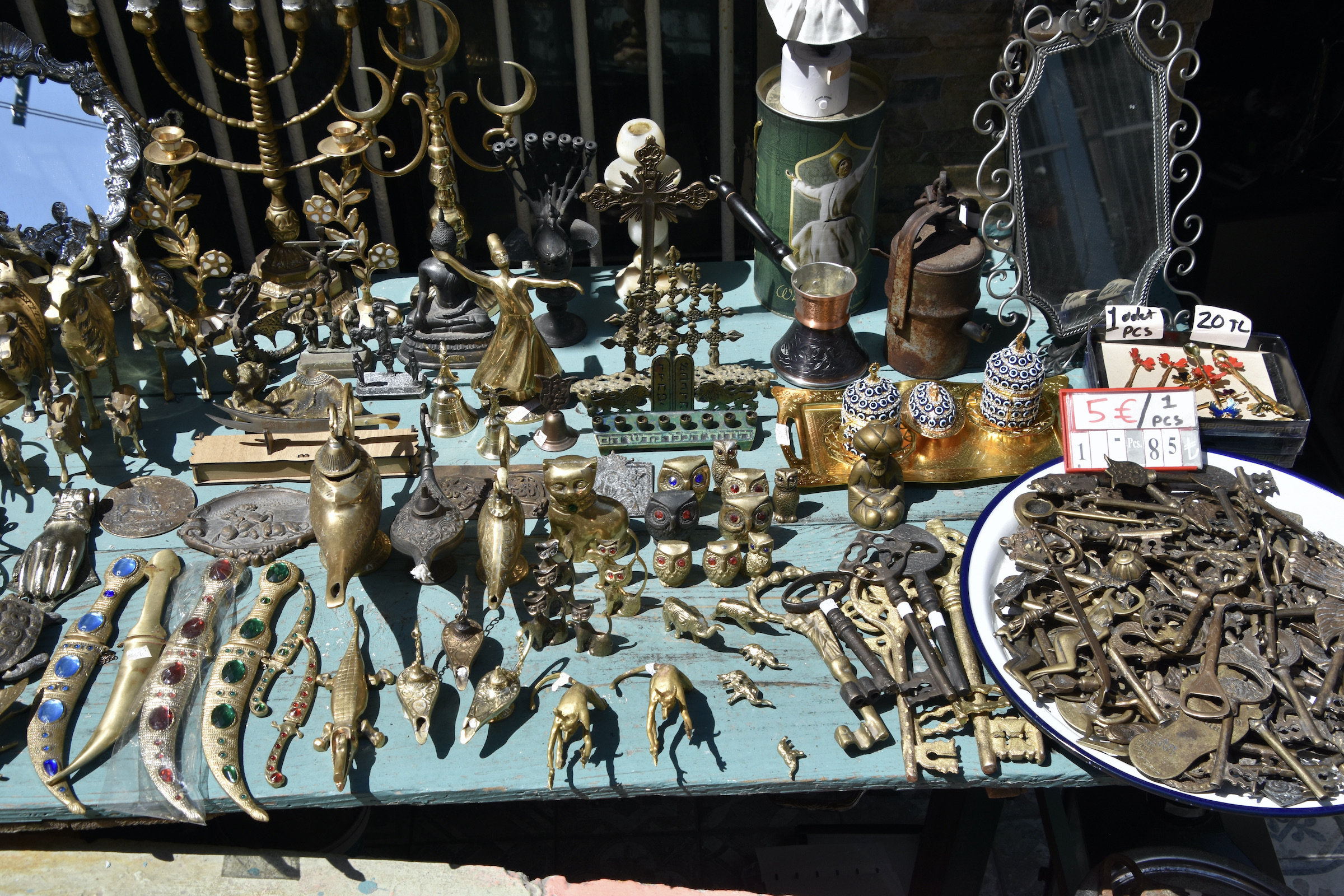
Balat immediately leapt to the top of my favourite Istanbul areas to just poke around in and is an appropriate place to end our unorthodox Istanbul tour.
In the next post we’ll visit two beautiful mosques, have a chance to buy some spices and then learn how to use them at a Turkish cooking class. Hope you’ll join us as the Via Egnatia tour gets into high gear.

